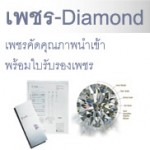
ผู้เชี่ยวชาญด้านเพชรของร้าน finejewelthai.com ที่ผ่านการอบรมระดับนนาชาติ จากสถาบันเพชรระดับโลก HRD และดีกรีของนักอัญมณี วทบ. มหาวิทยาลัยเชียงใหม่ ได้ประเมินค่าความงาม ความทรงคุณค่าและราคาของเพชรอยู่บนหลักที่เรียกว่า 4 Cs คือ Cut (การเจียระไน) ,Color (สี), Clarity (ความบริสุทธิ์) และ Carat weight (น้ำหนักคิดเป็นกะรัต) การทำความรู้จักกับ 4 Cs จะช่วยให้คุณได้เพชรที่ดีที่สุดสำหรับคุณ

การเจียระไนเพชร
การเจียระไนเพชรจากเพชรร่วงให้กลายเป็นเพชรที่สวยงามในรูปแบบต่าง ๆ Finejewelthai.com มีตัวอย่างของการเจียระไนที่ทำให้เพชรเกิดประกาย
สวยงามที่สุด
เข้าใจการเจียระไน
การเจียระไนเป็นสิ่งเดียวใน 4C ที่เราสามารถควบคุมได้ การเจียระไนที่ดีต้องเกิดจากทักษะและชำนาญของผู้เจียระไน ในการที่จะเปลี่ยนเพชรให้เป็นอัญมณีที่สวยงามได้ การเจียระไนที่ถูกต้อง เมื่อแสงส่องผ่านตัวเพชรแล้วจะต้องหักเห ออกมาเป็นประกายสีรุ้ง
การสร้างเพชรจะต้องมีการวัดขนาดหลายอย่าง ก่อนการเจียระไนซึ่งจะทำให้ได้มุมที่มีการหักเหแสงได้ดี หน้าเจียรที่ดีจะต้องมีมุมที่ถูกต้องแน่นอนโดยดูจากด้านบนและด้านล่างแบ่งครึ่งกัน ต้องมีสัดส่วนความหนาที่ลงตัว คือด้านเทเบิลหรือด้านบนสุด ต้องมีขนาดที่ถูกต้องเหมาะสมกับขนาดของเพชร แน่นอนว่าด้านบนสุดของหน้าเจียร(คลาวน์)ละด้านล่าง(พาวิลเลียน) ต้องให้ตรงเป็นแนวเดียวกัน
การวัดขนาดและสัดส่วนของเพชรจะมีความแตกต่างกันในแต่ละเม็ด ซึ่งจะมีผลในการตัดสินใจเจียระไนเพชรแต่ละเม็ดให้เป็นรูปทรงต่างๆ(รูปหัวใจ , รูปกลม, รูปไข่,เหลี่ยมมรกต, และรูปแบบอื่นๆ) เพชรแต่ละเม็ดจะมีรูปทรงที่เหมาะสมกับการเจียระไนที่แตกต่างกันออกไป รูปทรงของเพชรแต่ละเม็ดขึ้นอยู่กับหลายปัจจัย ถึงแม้ว่าคำว่ารูปแบบและการเจียระไน บางครั้งอาจใช้ร่วมกันได้ แต่มันก็ไม่เหมือนกัน รูปร่างที่นิยมเจียระไนกับเพชรคือ
รูปกลม – เป็นรูปแบบที่นิยมที่สุด
รูปมาคีย์ –เป็นแบบที่มีรูปร่างยาวและแหลมทั้งหัวท้าย
รูปปรินส์เซส –โดยทั่วไปจะเป็นเหลี่ยมสี่มุมถึงออกสี่เหลี่ยมผืนผ้าเล็กน้อย
รูปเรเดียน – โดยทั่วไปจะเป็นรูปสี่เหลี่ยมผืนผ้าเล็กน้อย
เจียระไนเหลี่ยมมรกต – เป็นรูปแบบดั้งเดิมจะมีแปดเหลี่ยมมีสัดส่วนเป็นรูปสี่เหลี่ยมผืนผ้า
แอสเซอร์ – บ่อยครั้งจะหมายถึง การเจียระไนแบบมรกตแบบจัตุรัสมันคือขั้นบันไดและจัตุรัสและตัดมุม
หยดน้ำ – เป็นการผสมกันระหว่างแบบบิลเลี่ยนกับแบบที่มีรูปร่างยาวงดงามแบบมาคีย์
รูปไข่ – ชวนให้นึกถึงรูปกลมแบบบิลเลี่ยนในด้านประกายและรูปร่าง
รูปหัวใจ–เป็นการเจียระไนที่เพ้อฝันรูปร่างคล้ายรูปหัวใจ
 |
รูปแบบการเจียระไนของเพชรแบบอุดมคติ
การเจียระไนในอุดมคติคือการเจียระไนที่เหมือนกับรูปแบบโครงร่างสัดส่วนของเพชรได้ทั้งความสูงทั้งการเล่นไฟและประกายที่ดี ถึงแม้ว่าจะเป็นการเจียระไนตามอุดมคติ จะแปรผันไปตามตัวแปรต่างๆ เช่นจากนักอัญมณี หรือในแต่ละประเทศ แต่สิ่งที่ตรงกันก็คือเพชรในอุดมคติต้องมีการเจียระไนที่ทำให้เมื่อแสงผ่านเมาแล้วสามารถสะท้อนเป็นประกายออกมาได้มากที่สุด โดยไม่ทะลุผ่านด้านข้างหรือด้านล่างไปก่อน
สัดส่วนของเพชร
การจัดเกรดการเจียระไนแบบรูปกลม (มนอุดมคติ,นิยมและดี) การวัดความกว้างของหน้าเทบิลคล้ายกับการวัดความกว้างของพลอยอื่น (คือเกอเดิลหรือความกว้างส่วนล่าง สำคัญสำหรับการเกิดประกายและไฟ หน้าเทเบิลเล็กหรือใหญ่ส่งผลต่อความสามารถในการเปล่ง ประกายของเพชร ซึ่งอาจเป็นสาเหตุให้เพชรบางเม็ดดูมีขนาดเล็กเมื่อเทียบกับน้ำหนักจริง เปอร์เซ็นต์ความลึกตั้งแต่หน้าเทเบิล(หน้าบนสุด) ถึงคิวเลท (ปลายแหลมของก้นหอย)แสดงเปอร์เซ็นต์ความกว้างของเพชร นี่คือความลึกถึงความกว้างสัมพันธ์กับสัดส่วนของเพชร เป็นผลทำให้เกิดการหักเหแสงและเล่นไฟดีและประกายดี
การคัดการเจียระไนเพชรแบบรูปกลม
การคัดเปอร์เซ็นต์ความลึกของหน้าเทเบิล
อุดมคติ 53% - 57% 59% - 62%
พิเศษ 58% - 63% 58% or 63%
ดี 64% - 65% 57.5 or 64%
การคัดเกรดในแลป(ห้องทดลอง) ไม่มีการคัดเกรดการเจียระไนพลอย ยกตัวอย่างในสถาบัน GIA จะไม่ตีราคาคุณภาพเพชรจากการเจียระไนดูเพียงรูปร่างกับวัดขนาดเท่านั้น อย่างไรก็ดีสัดส่วนของเพชร
(เปอร์เซ็นต์ความหนาและหน้าเทเบิล ความหนาของขอบเพชร ขนาดของคิวเลท (ถ้ามี)) ก็เป็นตัวกำหนด ราคาทั่วไปของพลอยประกอบด้วยการขัดเงากับสัดส่วน
สัดส่วนเป็นการอธิบายเกี่ยวกับปัจจัยต่างๆ คือ ขอบหน้าพลอยวางตรงกันหรือไม่ หน้าเจียระไนของเพชรด้าน ตรงข้ามกันแต่ละด้านตรงกันหรือไม่ หน้าพลอยด้านคลาวน์ หรือด้านบนของเพชรตรงกับด้านล่าง (พางิลเลี่ยน) หรือไม่ เวลาเลือกเพชรควรเลือกเพชรเกรดดีเยี่ยม
รูปร่างเพชรที่นิยมและเป็นแบบทั่วไปของเพชรก็คือแบบกลมหรือแบบเหลี่ยมเกสรจะมีห้าสิบเจ็ดหรือห้าสิบแปดหน้า (ขึ้นอยู่กับหน้าคิวเลทหรือปลายแหลมด้านล่างเพชรว่ามีหน้าเจียรหรือไม่) เป็นรูปรร่างที่นิยมนั่นคือเป๋นสิ่งที่ทุกคนจะ นึกถึงเมื่อคิดถึงเพชร แต่เจียรรูปแบบกลมก็ไม่ใช่รูปเดียว สามารถเจียรเป็นรูปแบที่เล่นไฟแบบอื่นและแบบเหลี่ยมเกสรได้
การเลือกรูปร่างที่เหมาะสมสำหรับคุณ ปัจจัยสำคัญในการหารูปร่างที่คุณสะดุดตาและเป็นอะไรที่ดูเหมาะสมกับมือของคุณ ทำให้นิ้วดูยาวขึ้นหรือสั้นลง ซึ่งคุณอาจพอในในรูปร่างแบบเก่าชอบแบบรูปกลมแบบเหลี่ยมเกสร แบบหยดน้ำ มาคีย์หรือหัวใจ รูปร่างเพชรที่คุณเลือกเป็นรูปร่างที่คนทั่วไปเลือก รูปร่างการเจียรแต่ละแบบก็ส่งผลต่อประกายต่างกันรวมถึงขนาดที่ปรากฏ และค่าของมัน
การเจียระไนแบบเหลี่ยมเกสรกลมจะแสดงประกายและเล่นไฟได้มากกว่ารูปร่างอื่นๆ เมื่อจะต้องการซ่อนความผิดปกติจองเพชร การเจียรแบบกลมนี่แหละจะทำได้ดีที่สุด มันถูกออกแบบมาให้ซ่อนตำหนิและจุดสีเหลืองได้ดีกว่าแบบอื่น ในการเจียรแบบมรกตและแบบบาเกมันจะมีหน้าเหลี่ยมที่ยาวจะเห็นตำหนิชัดเจน
เหลี่ยมมรกตดูดึงดูดใจมันไม่ค่อยมีประกาย ถ้าคุณชอบรูปเหลี่ยมหรือเหลี่ยมผืนผ้าของรูปร่างแบบมรกต คุณอาจจะต้องการพิจารณารูปรัศมีรูปปรินเซสหรือการ์ดิวเลี่ยน ซึ่งจะมีหน้าเจียรมากและทำให้มีประกายมาก ถ้าคุณต้องการเพชรที่ดูใหญ่แต่ถ้ามันมีน้ำหนักไม่มาก พิจารณาจากรูปร่างแฟนซีอย่างมาคีย์หรือหยดน้ำ ซึ่งดูใหญ่และยาวกว่าเพชรรูปกลมเมื่อน้ำหนัก กะรัตเท่ากัน
การเรืองแสง
----------------------------------------------------------------
สี
เพชรที่ดีต้องใสไม่มีสี เพชรของ Finejewelthai.com จะมีสีที่น้อยที่สุดที่จะเป็นไปได้ทำความเข้าใจเรื่องสี เป็นสิ่งที่เราต้องรู้อยู่แล้วเพชรที่ใสไม่มีสีจะมีค่ามาก เพชรที่พบในธรรมชาติมีช่วงกว้างของสีจากไม่มีสีสีเหลืองเล็กน้อย สีน้ำตาล และมีสีอื่นๆที่เรียกกันว่าสีแฟนซีเป็นสีจัดเช่นสีเหลืองและฟ้า แต่จะไม่นำมาประเมินเป็นมาตรฐานเดียวกัน
การคิดเกรดสีจะต้องใช้ตัวอักษรตั้งแต่ D ถึง Z D คือไม่มีสีและเป็นสีที่ดีที่สุด Z จะเป็นสีที่เป็นสีปรกติและไม่มีราคา สีของเพชรจุถูกตัดสินโดยการดูภายใต้แสงที่ถูกควบคุมไว้และเทียบโดยสถาบัน HRD ซึ่งเป็นพื้นฐานของกลุ่มสีเพชรเป็นแผนภาพบอกสีในการเกรดสีเพชร
----------------------------------------------------------------
ความบริสุทธิ์
เพชรเป็นจำนวนมากมักมีตำหนิที่ทำให้เกิดการหักเหของแสงผิดพลาด ซึ่งทำให้เพชรไม่เปล่งประกายเท่าที่ควร แต่เพชรของเรามีความบริสุทธิ์ อยู่ในเกรดสูงสุด ซึ่งสามารถมั่นใจได้ในความเปล่งประกายของมัน
ความเข้าใจด้านคุณภาพ
เป็นสิ่งที่สำคัญมากในการเกรดตำหนิ สำคัญต่อคุณภาพของเพชร บอกถึงจำนวนตำหนิ ตำแหน่งและขนาดของมัน เป็นสิ่งที่เกิดขึ้นตาม ธรรมชาติ ถ้ามีตำหนิน้อยและน้อยมากก็ส่งผลอย่างมากต่อค่าของเพชร นี่คือภาพที่แสดงการเกรดคุณภาพที่สร้างโดยผู้ที่รอบรู้ด้านเพชร ระดับโลก HRD
F ปราศจากตำหนิ เพชรที่ไร้ตำหนิหรือตำหนิแบบเล็กมากดูไม่ได้ภายใต้กำลังขยาย 10x โดยนักเกรดเพชรที่มีประสบการณ์ไม่มีตำหนิจรองๆหรือปราศจากตำหนิภายใน เป็นเพชรที่หายากมากที่สุด
IF เป็นเพชรที่ไม่มีตำหนิเลยเมื่อพิจารณา โดยนักเกรดเพชรผู้เชี่ยวชาญภายใต้กำลังขยายสิบเท่า แต่ก็อาจจะมีตำหนิเล็กน้อย
VVS1 VVS2 เป็นเพชรที่มีตำหนิน้อยมากยากที่จะเห็นภายใต้กำลังขยายสิบเท่า โดยผู้เกรดเพชรผู้มีประสบการณ์
VS1 VS2 เป็นเพชรที่มีตำนหิน้อยมาก เช่นพวกผลึกขนาดเล็ก,กลุ่มของตำหนิหรือตำหนิคล้านขนนก เมื่อพยายามสังเกตภายใต้กำลังขยายสิบเท่า
SI1 SI2 เป็นเพชรที่มีตำหนิ (กลุ่มตำหนิ,ผลึก,ตำหนิคล้ายแผ่นกระจก,หลุมบนเพชร และตำหนิคล้ายขนนก) จะเห็นได้ชัดเมื่อมองภายใต้กำลังขยายสิบเท่าโดยเชี่ยวชาญด้านการเกรดเพชร
I1 I2 I3 เป็นเพชรที่มีตำหนิ (รูปขนนกขนาดใหญ่ หรือ ผลึกขนาดใหญ่)เห็นได้ชัดเจนภายใต้กำลังขยายสิบเท่า และอาจมีผลต่อความใส และความเป็นประกายของเพชร
----------------------------------------------------------------
กะรัต
กะรัตเป็นค่าแสดงน้ำหนักและขนาดของเพชร เรามีตารางแสดงน้ำหนักต่อ กะรัตของเพชร ตั้งแต่หนึ่งส่วนสี่ถึงห้ากะรัต ซึ่งช่วยให้คุณสามารถเลือก
เพชรที่ดูดีที่สุดบนนิ้วของเธอได้ง่ายขึ้น
ความเข้าใจด้านน้ำหนักกะรัต
น้ำหนักของเพชรเป็นการวัดที่มีหน่วยกะรัต ซึ่งเป็นหน่วยที่เล็กเท่ากับ 200 มิลลิกรัม น้ำหนักกะรัตไม่สามารถใช้วัดขนาดของเพชรได้เนื่องจากการเจียระไนเพชรเป็นสัดส่วนแตกต่างกันสามารถส่งผลต่อน้ำหนักเพชรได้ (คำว่า กะรัตเป็นคำที่ใช้บอกความบริสุทธิ์ของทองและไม่ใช้กับเพชร)
ข้อควรจำ เมื่อได้น้ำหนักกะรัตของเพชรมา ซึ่งนั่นไม่ได้เป็นปัจจัยเดียวที่กำหนดราคาของเพชร คือขนาดใหญ่ไม่ได้แปลว่าดีเสมอไป กฎ 4C ทั้งหมดต้องสมดุลกันปรากฏในเพชรของคุณ กฎ 4C ต้องใช้ร่วมกันไม่ใช่ว่ากฎข้อใดจะมีความสำคัญมากกว่าข้ออื่น
คำว่ากระรัตแท้จริงแล้วมาจากคำว่าการอป (คือเมล็ดการอป) ซึ่งเป็นการวัดน้ำหนักของเพชรในสมัยก่อน ในปี 1913การวัดน้ำหนักของเพชรได้ถูกทำเป็นมาตรฐานเดียวทั่วโลกและปรับเปลี่ยนเป็นระบบเมตริก อย่างไรก็ดีเราสามารถวัดอัญมณีได้เมื่อยังไม่ได้เข้าตัวเรือน เพชรที่มีน้ำหนักถูกต้องแน่นอน เมื่อยังไม่ได้เข้าตัวเรือน ห้องปฎิบัติการอัญมณีอย่างสถาบัน HRD จะเกรดเพชรเฉพาะที่ยังไม่ได้เข้าตัวเรือน ในรายงานการเกรดเพชรจะบอกเกี่ยวกับน้ำหนักกะรัตที่แน่นอน ใกล้เคียงกับหนึ่งในร้อยกระรัตสำหรับเพชรโดยเฉพาะ แต่ละกะรัตจะถูกแบ่งเป็นร้อยส่วนที่เรียกว่าพล๊อย (คะแนน) ซึ่งหนึ่งกะรัตจะมีค่าเท่ากับ หนึ่งร้อยคะแนน ถ้า สามส่วนสี่กระรัตจะเท่ากับ เจ็ดสิบห้าคะแนน คะแนนในส่วนของกะรัตจะถูกแบ่งเป็นช่วงๆ ซึ่ง สามส่วนสี่กระรัตของเพชรจะมีค่าอยู่ระหว่าง หกสิบเก้า ถึง แปดสิบสอง คะแนน ซึ่งยังคงพิจารณาให้เท่ากับ สามส่วนสี่กะรัต นี่เป็นภาพที่แสดงช่วงขนาดและน้ำหนักเศษส่วนของกะรัตและเลขทศนิยมที่เห็นจะมีค่าเท่ากัน
น้ำหนักเศษส่วน | เลขทศนิยม | |
1/10 | = | .09 - .11 |
1/8 | = | .12 - .13 |
1/7 | = | .14 - .15 |
1/6 | = | .16 - .17 |
1/5 | = | .18 - .22 |
1/4 | = | .23 - .28 |
1/3 | = | .29 - .36 |
3/8 | = | .37 - .44 |
1/2 | = | .45 - .58 |
5/8 | = | .59 - .68 |
3/4 | = | .69 - .82 |
7/8 | = | .83 - .94 |
1.0 | = | .95 - 1.05 |
ข้อควรจำ เพชรนั้นไม่ถูกสร้างออกมาให้มีค่าเท่ากัน เพชรสองเม็ดที่มีขนาดน้ำหนักเท่ากันอาจจะมีค่าแตกต่างกันออกไประหว่างการเจียระไน สี และคุณภาพ ซึ่งน้ำหนักกะรัตสามารถซ่อนความแตกต่างของเพชรแต่ละเม็ดได้ เช่น คุณมีเพชรที่มีการเจียระไนดี ซึ่งมีน้ำหนักอยู่ในช่วงที่ถูกต้อง เพชรมีการเจียระไนที่ไม่ลึกทำให้มันดูกว้างและใหญ่มากแต่มันมีประกายไม่ดี หรือทำให้การเจียระไนดูลึกมากเพื่อเพิ่มน้ำหนักของเพชร มันสามารถยอมรับได้ถ้ามันช่วยให้พลอยมีประกายดีขึ้น จากความรู้ด้านการเจียระไน
น้ำหนักกะรัตของเพชรเป็นปัจจัยที่สำคัญที่สุดที่จะกำหนดราคาของเพชร พื้นฐานของค่าของเพชรต่อกะรัต เพชรที่มีคุณภาพดีอาจขายได้ถึง 660,000 บาท ต่อกะรัต ซึ่งถ้ามีคุณภาพต่ำอาจขายได้ 33,000 บาท ต่อกะรัต ซึ่งเพชร 3 กะรัตควรจะเป็น 1,980,000บาท หรือ 99,000บาท ขึ้นอยู่กับค่าต่อกะรัตของมันค่าของเพชรจะเพิ่มขึ้นตามนาดเพชรได้ เช่นสองกระรัตจะไม่ได้มีราคาเท่ากับ สองเท่าต่อกระรัตเหมือน หนึ่งกะรัตมันไม่ได้มีค่าอย่างนั้นเสมอไป เพชรขนาดใหญ่นั้นหายาก
----------------------------------------------------------------
ใบรับประกันคุณภาพ
ใบรับประกันเป็นสิ่งที่ช่วยการันตีมีคุณภาพของเพชร เพชรของเราได้รับการรับรอง จากสถาบันด้านการคัดคุณภาพเพชรที่ได้รับการยอมรับสูงสุดของโลก
ใบรับประกันเครื่องประดับ-ใบรับรองเพชร - การบริการหลังการขาย
ใบรับประกันเครื่องประดับ ทำให้ท่านลูกค้ามั่นใจถึงคุณภาพเครื่องประดับว่ามีลักษณะ ชนิดของโลหะ ชนิดของพลอย น้ำหนักโลหะเป็นกรัม น้ำหนักของพลอยเป็นกะรัต ขนาดของพลอย เปอร์เซ็นต์ของโลหะที่ใช้ และคุณภาพอยู่ในเกณฑ์ใดที่ทางเราได้แจ้ง ไม่มีการโฆษณาเกินจริง ใช้วัสดุตามที่แจ้งในรายละเอียด ซึ่งเราบอกอย่างละเอียดในใบรับประกันเครื่องประดับทุกชิ้น เมื่อมีหลักฐานมายืนยันการตรวจสอบ ท่านจะได้รับความสบายใจ และเชื่อมั่นในคุณภาพสินค้า จากทางร้าน ไฟน์ ซิลเวอร์ แอนด์ จิวเวลรี่ ซึ่งท่านจะไม่เคยได้รับบริการแบบนี้จากร้านเครื่องประดับทั่วไป ที่ไม่มีผู้เชี่ยวชาญด้านเครื่องประดับ และอัญมณี ที่เป็นผู้ตรวจสอบ และรับรองวัสดุที่ใช้ผลิตเครื่องประดับแต่ละชิ้น
เรามีความยินดีที่จะรับประกันความพอใจ หากสินค้าไม่ตรงตามใบรับประกันเครื่องประดับ หากท่านตรวจพบ และมีหลักฐานที่เชื่อถือได้ ทางร้านยินดีที่จะคืนเงินเต็มจำนวน โดยไม่หักค่าใช้จ่ายใดๆ โดยทางเรามี นโยบายการเปลี่ยนสินค้า และนโยบายการประกันความพอใจ ตามเงื่อนไขที่ระบุไว้ในนโยบาย
ใบรับรองคุณภาพเพชรอะมอเร่ ไดมอนด์- การบริการหลังการขาย
เกี่ยวกับใบรับรองคุณภาพเพชร รายงานคุณสมบัติของเพชร จะต้องมีรายละเอียดบอกให้ครบถ้วน ทั้ง 4C คือน้ำหนักเป็นกะรัต (carat) , สี (color) , ความใส (clarity) , รูปแบบการเจียระไน (cutting) คุณสมบัตินี้ ต้องบอกเป็น ระดับมาตรฐาน คุณภาพเพชร ใช้กันทั่วโลก ผู้ซื้อจะมั่นใจได้ว่าเพชรเม็ดนั้น ๆ มีคุณค่า และคุณสมบัติอย่างไร โดยทั่วไปแล้วเพชรที่ผ่านการคัดคุณภาพ และมีใบรับรอง โดยผู้เชี่ยวชาญที่ผ่านการทดสอบจากสถาบันระดับโลก HRD และนักอัญมณี Gemologists (วทบ.อัญมณีวิทยา มหาวิทยาลัยเชียงใหม่) และเพชรที่มีใบรับรองจะมีราคาสูงกว่าเพชรทั่วไปที่ไม่มีใบรับประกัน ท่านจะมั่นใจได้ว่า เครื่องประดับทุกชิ้นที่ผลิตจากร้านไฟน์ ซิลเวอร์ แอนด์ จิวเวลรี่ ได้ผ่านการตรวจสอบทุกขั้นตอน ตั้งแต่เปอร์เซ็นต์ของโลหะมีค่าที่ใช้ พลอย และเพชรที่ใช้ พร้อมสินค่าที่ผ่านการกลั่นกรองทางความคิด ออกแบบโดยนักออกแบบเครื่องประดับ ที่มีประสบการณ์นานกว่า 10 ปี และช่างฝีมือที่ผ่านงานระดับประเทศและต่างประเทศมามากกว่า 20 ปี


เพชรคุณภาพ ของ อะมอเร่ ไดมอนด์ Amore Diamond ในเครือของ ร้านไฟน์ ซิลเวอร์ แอนด์ จิวเวลรี่ Fine Silver and Jewelry
เพชรอะมอเร่ ไดมอนด์ เป็นเพชรที่ผ่านการรับรองจาก ผู้ตรวจสอบคุณภาพเพชร (CDG) ที่ได้รับประกาศนียบัตร และผ่านการทดสอบ จาก สถาบัน HRD เมืองแอนท์เวิพ ประเทศเบลเยี่ยม ซึ่งเป็นสถาบันที่เป็นที่ยอมรับและ มีชื่อเสียงไปทั่วโลก ในเรื่องของการออกใบรับรองคุณภาพและ คุณสมบัติ ของเพชร จากผู้ค้าทั่วโลก
นอกจากนี้เพชรขนาดตั้งแต่ 0.30 กะรัต ขึ้นไป และมีใบรับรองจากสถาบันรับรองเพชร ระดับโลก HRD, GIA, IGI ที่ทางร้านของเราจำหน่าย พร้อมกับเพชรร่วง ท่านสามารถ ตรวจสอบเลขที่ใบเซอร์ ว่าเป็นจริงและมีจริง ตามที่แจ้งในใบเซอร์ไหม กับเว็บไซด์ของสถาบันนั้นๆได้เลย และปัจจุบันเพชรที่ออกใบเซอร์ จะมีเลขที่ของใบเซอร์ที่ขอบเพชร หรือ girdle ทุกเม็ด ตามรูปที่แนบมาด้านล่าง ทำให้ท่านมั่นใจได้ว่าเพชร เม็ดนั้น เป็นเพชรที่เซอร์ตรงตามใบจริงมาจากสถาบันต่างๆ

ท่านสามารถตรวจสอบใบเซอร์ CERTIFICATE GIA, HRD, IGI ง่ายๆ โดยใส่ข้อมูลเพียง 2 อย่างของเพชรตามข้อมูลด้านล่าง
1. Certificate Number: ****
2. Carat (weight): ***
*เฉพาะ IGI คลิกเลือกที่เมืองก่อน แล้วใส่นัมเบอร์ของใบเซอร์
GIA Report Check : http://www.gia.edu/reportcheck
HRD Antwerp Certificate Link : http://www.hrdantwerplink.be
IGI Report Check : http://www.igiworldwide.com/en/onl_data.htm
ลูกค้าของทางร้านจึงมั่นใจได้ว่า * เพชรทุกเม็ดของทางร้านได้ผ่านการรับรองว่าเป็นเพชรแท้ และคุณภาพอยู่ในมาตรฐานโลก *
ในราคามิตรภาพ และส่วนลดพิเศษ ที่คุณสามารถเป็นเจ้าของและกำหนดราคาเองได้ โดยไม่ต้องไปซื้อถึงประเทศเบลเยี่ยม ชมเครื่องประดับคุณภาพของร้านไฟน์ ซิลเวอร์ แอนด์ จิวเวลรี่ ที่เคาน์เตอร์กาดสวนแก้ว เชียงใหม่ หรือแวะชม www.amore-diamond.finejewelthai.com
“แบบเฉพาะบ่งบอกถึงความเป็นคุณ..... มากคุณค่าด้วยความแตกต่าง..... ในราคาที่คุณกำหนดได้”
การดูแลรักษาเพชรและทำความสะอาดเพชร
เพชรที่มีค่าของคุณ ที่คุณซื้อมา คุณจะต้องรักษาอย่างถูกต้องและแน่ใจว่ามันจะถูกทำให้อยู่ในสภาพนี้ตลอดไป หลักพื้นฐานที่จะช่วยให้เพชรของคุณดูดี
1. การดูแลเพชร
2. การทำความสะอาดเพชรของคุณ
3. ท่องเที่ยวไปกับเพชร
1. การดูแลเพชร
เพชรเราจะต้องเก็บทำความสะอาดและระมัดระวังเมื่อไม่สวมใส่เป็นพิเศษ เพราะคนส่วนใหญ่จะใส่แหวนหมั้น 24 ชม. , 1 วัน,7 วัน,1 สัปดาห์ มันเป็นสิ่งสำคัญมาก คุณควรดูแลเอาใจใส่อย่างทนุถนอมเสมอๆ
ควรหลีกเลี่ยงการสวมใส่ขณะกำลังทำงานบ้านหรือทำงานหนัก
ถ้าหินหรืออัญมณีของคุณเกิดหลวมหรือเกิดความเสียหาย ไม่ควรสวมใส่อัญมณีนั้นควรนำไปให้ผู้เชี่ยวชาญอัญมณีดูแลทันที ควรหมั่นตรวจสอบอัญมณีของคุณทุกๆ 1ปี
2. การทำความสะอาดเพชรของคุณ
- เมื่อเพชรเกิดเป็นรอยด่างดำ สกปรกและเปื้อนฝุ่น ควรทำความสะอาดด้วยโลชั่น น้ำมันจากธรรมชาติอ่อนๆ สารเคมีในอากาศจะออกซิไดซ์หรือมีการเสียดสี ควรเก็บรักษาทำความสะอาดเครื่องประดับเพื่อที่จะมีความสุกใสมากยิ่งขึ้น
- การชำระสิ่งสกปรก ใช้แปรงอ่อนๆกับเครื่องประดับ แปรงเบาๆทำให้เกิดฟองไปรอบๆเครื่องประดับ แล้วล้างออกด้วยน้ำอุ่น แล้วซับให้แห้งด้วยสำลี
- ล้างน้ำเย็น ทำสารละลาย 4 ส่วน และ 1 ส่วน เป็นน้ำยาล้างจานอ่อนๆ ควรล้างหลายๆ นาที ใช้แปรงอ่อนๆขัดไปรอบๆ แล้วล้างออกด้วยสารละลายอีกครั้งหนึ่ง และซับด้วยกระดาษทิชชู่
- การดูแลอย่างรวดเร็ว ควรเลือกดูหินที่ดีที่สุด อ่านรายละเอียดและคำแนะนำให้เข้าใจ อย่าสัมผัสเพชรสะอาดของคุณโดยนิ้วมือของคุณ เพราะมือของคุณมีน้ำมันทำให้เกาะติดหินของคุณได้
- การทำความสะอาดแบบอัลตราโซนิค พวกเขาทำความสะอาดเครื่องประดับแต่ละชิ้นด้วยการล้างในของเหลว
3. ท่องเที่ยวไปกับเพชร
เมื่อคุณเดินทางท่องเที่ยวควรดูแลเครื่องประดับเพชรอันมีค่าของคุณให้ดีที่สุด เครื่องประดับมีการออกแบบให้เข้ากับการเดินทางทั้ง ขนาด รูปร่าง แบบ หาง่าย ส่วนใหญ่ด้านในจะรองด้วยกำมะหยี่ติดกับpin
และต่างหู
เมื่อคุณจะล้างมือคุณควรถอดเอาเครื่องประดับออกวางไว้ มันสามารถหล่นลงในท่อเพราะมันเป็นชิ้นเล็กๆ เมื่อคุณออกจากบ้านพัก โดยไม่หยิบเครื่องประดับของคุณหรือลืมหยิบในสถานที่เอกชน คุณอาจจะสูญเสียมันไปตลอดไป----------------------------------------------------------------
เพชรที่มีค่าของคุณ ที่คุณซื้อมา คุณจะต้องรักษาอย่างถูกต้องและแน่ใจว่ามันจะถูกทำให้อยู่ในสภาพนี้ตลอดไป หลักพื้นฐานที่จะช่วยให้เพชรของคุณดูดี
2. การทำความสะอาดเพชรของคุณ
3. ท่องเที่ยวไปกับเพชร
เพชรเราจะต้องเก็บทำความสะอาดและระมัดระวังเมื่อไม่สวมใส่เป็นพิเศษ เพราะคนส่วนใหญ่จะใส่แหวนหมั้น 24 ชม. , 1 วัน,7 วัน,1 สัปดาห์ มันเป็นสิ่งสำคัญมาก คุณควรดูแลเอาใจใส่อย่างทนุถนอมเสมอๆ
ควรหลีกเลี่ยงการสวมใส่ขณะกำลังทำงานบ้านหรือทำงานหนัก
ถ้าหินหรืออัญมณีของคุณเกิดหลวมหรือเกิดความเสียหาย ไม่ควรสวมใส่อัญมณีนั้นควรนำไปให้ผู้เชี่ยวชาญอัญมณีดูแลทันที ควรหมั่นตรวจสอบอัญมณีของคุณทุกๆ 1ปี
- เมื่อเพชรเกิดเป็นรอยด่างดำ สกปรกและเปื้อนฝุ่น ควรทำความสะอาดด้วยโลชั่น น้ำมันจากธรรมชาติอ่อนๆ สารเคมีในอากาศจะออกซิไดซ์หรือมีการเสียดสี ควรเก็บรักษาทำความสะอาดเครื่องประดับเพื่อที่จะมีความสุกใสมากยิ่งขึ้น
ข้อแนะนำสำหรับการเลือกซื้อแหวนแต่งงาน - แหวนหมั้น
ด้วยสไตส์ที่ชอบกับราคาที่คุณคิด คุณสามารถเรียนรู้ที่จะเลือกเพชรที่ดีที่สุดสำหรับเธอ ที่จะนำมาทำแหวนแต่งงาน และ แหวนหมั้น
แหวนหมั้น
แหวนหมั้น คือสิ่งที่สำคัญมากที่สุดของคุณ มันแสดงถึงความรักและคำหมั้นสัญญาของคุณ และสะท้อนถึงความดีของเธอ แหวนหมั้นได้รับการยอมรับว่ามีคุณภาพสูงสำหรับคนสวย
การตั้งงบที่สมดุลของคุณเมื่อคุณตั้งงบประมาณของคุณ คุณมีความคิดที่จะซื้อหิน(แหวนหมั้น) การตั้งมาตรฐานของการใช้เงิน 2 เดือนกับแหวนหมั้นเป็นจุดเริ่มต้นที่ดี ก่อนที่คุณจะตั้งหลักปักฐาน บางเวลาอาจเรียนรู้เกี่ยวกับคุณภาพเพชรที่คุณกำลังมองหาทั้งคู่ มันเป็นคุณภาพของเพชรที่คุณจะได้ใช้ให้เหมาะสมกับราคา เพชรคุณภาพสูงที่สุดเท่านั้นที่คุณจะได้สำหรับงบประมาณทั้งหมดของคุณ
การเรียนรู้เกี่ยวกับเพชร
การที่ชอบซื้อสิ่งที่สำคัญใดๆ คุณควรดูกำลังซื้อหิน(แหวนเดิม) การตั้งมาตรฐาน การใช้เงินของคุณสองเดือนกับแหวนหมั้นเป็นจุดเริ่มต้นที่ดี ก่อนที่คุณจะตั้งหลักปักฐาน บางเวลาอาจเรียนรู้เกี่ยวกับคุณภาพเพชรที่คุณกำลังมองหา ทั้งคู่มันเป็นคุณภาพของเพชรที่คุณจะได้ใช้ให้เหมาะสมกับราคา เพชรคุณภาพสูงที่สุดเท่านั้นที่คุณจะได้สำหรับงบประมาณทั้งหมดของคุณ
จากการตัดเป็นวงกลม แล้วแม้แต่รูปหัวใจ ถือว่าเป็นรูปร่างที่สวยของเพชรซึ่งกำลังเป็นที่ยอมรับ คุณควรเลือกรูปร่างที่ดีที่สุดที่เหมาะสมกับสไตล์ของเธอ เพราะเพชรคือหินที่มีชื่อเสียงมากที่สุด
ขนาดมันเป็นสิ่งสำคัญเพื่อที่จะเลือกเพชรว่าเหมาะสมกับงบประมาณของคุณ คุณสามารถเลือกได้หลากหลายแบบของเพชร ซึ่งเป็นการบ่งบอกทำให้คุณแน่ใจว่าคุณจะได้แหวนที่มีค่าสมบูรณ์ การศึกษาด้วยตัวคุณเองเกี่ยวกับ 4C ข้อเท็จจริงที่เกี่ยวกับเพชรซึ่งคุณควรจะรู้ก่อนที่จะซื้อเพชร การศึกษาด้วยตัวเองเกี่ยวกับกุญแจทั้ง 4C (ตัด,ความใส,สีและน้ำหนักกะรัต) และการคัดเกรดเป็นกฎเกณฑ์ที่คุณจะทำตัด การตัดเป็นคุณภาพของเพชรอย่างหนึ่ง เกี่ยวกับการเจียร
สี ควรพิจารณาสีของเพชรว่าสีขาว หรือสีแฟนซี (ชมพู,ฟ้า ,เหลือง ) 4c นี้จะใช้คัดเกรดเฉพาะเพชรสีขาวเท่านั้นเพราะสีเพชร สีขาวมีค่ามากที่สุด (มีราคา)มากที่สุด คือสีใส หรือไม่ใช้สีเหลืองหรือสีน้ำตาล
ความใส ความใสเป็นการอ้างอิง พูดถึง “มลทิน”,ตำหนิ,ในเพชร ถ้าเพชรมีตำหนิน้อยก็จะส่งผลต่อราคาของมัน น้ำหนักกะรัต การวัดน้ำหนักของเพชร เป็นปัจจัยหนึ่งที่ส่งผลให้เพชรมีราคาแพงขึ้น
การเลือกแหวนข้างขวาดูสไตล์,โลหะ และการมองลูกเล่นรูปร่างของเพชร ทั้งหมดในแหวน,สไตล์ในตัวเธอจะช่วยนำทางให้คุณเลือกแหวนหมั้นของคุณได้ เราออกแบบโดยเครื่องมือ เพื่อค้นหาแหวนของคุณได้โดยง่ายและรวดเร็ว เพื่อทำแหวนของเธอให้สมบูรณ์ จากทองคำเหลือง 14 K ถึงทองคำขาว 18 K และแม้แต่แพลทตินัม, การเลือกสิ่งของที่เหมาะสมที่สุดที่คุณต้องการและความปรารถนาของงบประมาณของคุณ จัดหินในสไตล์ของคุณ Finejewelthai.com มีความแตกต่างของแหวนหมั้นแต่ละสไตล์ มีชื่อเสียงในการจัดการด้านหินมาก เพชรหรืออัญมณี สามารถเพิ่มความสวยงามให้แก่แหวน เพชรจะเป็นศูนย์กลางวงแหวนเพชร 2 แสดงเพิ่มเติมหรือที่ที่มีแสงน้อ























แสดงความคิดเห็น